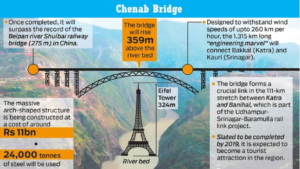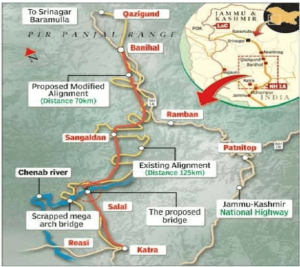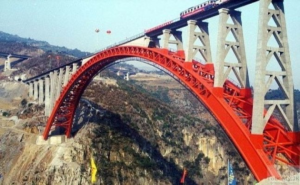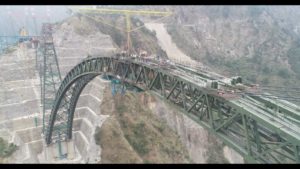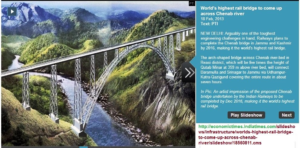Construction[edit]
The Chenab Rail Bridge was originally intended to be completed in December 2009.[14] However, in September 2008, the project was halted due to fears over the bridge’s stability and safety.[15] Work on the bridge restarted in 2010,[16] with the plan to complete it in 2015.[17]
The design and construction was awarded to Afcons Infrastructure,[18] a part of the Shapoorji Pallonji Group, the third-largest construction group in India, with the help of IISc Bangalore. Major construction decisions were taken by Konkan Railway Corporation. The Defence Research and Development Organisation (DRDO) helped in the design of the bridge, making it blast-proof using special steel.[19]
The erection scheme for the bridge is a project in itself. Two pylons (about 130 m and 100 m high) were erected on either side of the river, and two auxiliary self-propelled cable cranes (capacity of 20 tonnes each) were used to tow temporary auxiliary ropes across these pylons. The ropes were used to support the partly finished arch parts. After arch completion, the trusses will be added, finally the girder will be constructed as a horizontal sliding type platform.
Project status[edit]
- Jul 2017: Construction work resumed on the bridge.
- Nov 2017: The work bridge’s arch is was expected to be completed By May 2019.[3]
- Nov 2018: The bridge is now under active construction.[20]
- Dec 2018: The project was expected to be completed by the end of 2019, but at this time, it seems unlikely.[21][22]
- Aug 2019: 80% of construction work has been completed on the bridge, and is expected to be opened in mid-2020.[23]
- Nov 2019: 83% work has been completed on the bridge, and is now expected to be opened in March 2021.[24]
- Jan 2020: It is now expected to be opened in December 2021.[25]
- April 2021: Work on both the ends of the bridge’s arch is finally completed. It is now expected to be opened in 2022.[26][2]
- June 2022: About 90% of construction work has been completed, and is now confirmed to make the bridge operational by December 2022.[27]
Maintenance[edit]
Regular painting of large bridges is an intimidating task; hence, a painting scheme was developed, having renewal of over 15 years, compared to approx. 5 to 7 years in most other Indian railway bridges.[28]
S. JAYABARATHAN [JULY 23, 2022]
- நங்கூரி
- ஷோபாசக்தியின் புதிய நாவல் ஸலாம் அலைக்
- ‘பண்ணையில் ஒரு மிருகம்’ – எழுதியவர் டாக்டர் நடேசன்
- பொங்கியது பால்
- இந்தியாவின் ஜம்மு-காஷ்மீர் இமயச் சரிவில் உலகிலே உயர்ந்த இரும்பு வளைவு இரயில் பாலம்
- தக்கயாகப் பரணி [தொடர்ச்சி]
- ஐனநாயகச் சர்வாதிகாரம்
- பூதக்கோள் வியாழன், வெள்ளிக்கோள் இடையே உள்ள ஈர்ப்பு விசை மாறுதலால், பூமியின் சுற்றுப்பாதை மாறிப் பெருத்த உயிரினப் பாதிப்பு நேரலாம்
- மேடம் இன்னிக்கு…
- கைவசமாகும் எளிய ஞானம்
- ரசவாதம்
- உன்னுள் இருந்து எனக்குள்
